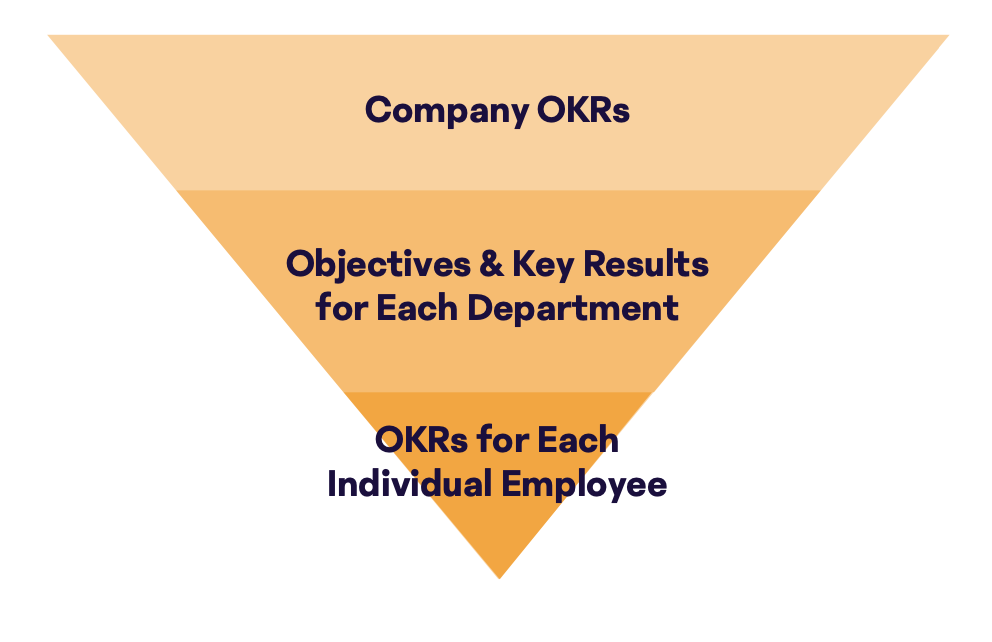Objectives and Key Results (OKR) is a critical thinking framework and goal-setting methodology that helps companies to align goals and ensure everyone is working collaboratively on goals that really matter.
Objectives are what the organization, team, or individual wants to accomplish, and are typically qualitative and time-bound. The Key Results are concrete, specific, and measurable, and describe how you’ll accomplish the Objective. The objective is the what, and the key results are the how, where, and when.
Back in the 1970s, As a CEO at Intel, Andy Grove took the idea of MBO from Peter Drucker and upgraded it with the concept of Key Results. Thus, OKRs were born, and Andy Grove became the father of the OKR framework. And then the OKRs concept spread to other Silicon Valley companies. Google adopted OKR in 1999, during its first year. It supported Google's growth from 40 employees to more than 60,000 today. Besides Google, other companies use OKR, including Spotify, Twitter, LinkedIn, and Airbnb.
The OKR methodology is a simple process of setting and aligning company and team goals (Objectives) and connecting each Objective with 3-5 measurable results (Key Results) to measure progress. For example, increase _____ from X to Y. Reduce ______ by X%. Improve ______ up to X%. Key Results can be measured on a 0-100% scale or any numerical unit (ex: dollar amount, %, items, etc.).
A more detailed example would be like this:
Objective: Make our company go viral Key Results:
KR1: Generate 100,000 views on our Youtube channel
KR2: Get 10,000 new followers on Instagram
KR3: Increase organic search traffic to our website by 20%
Instead of simply saying “we’re getting there” and “we’re shooting the moon” as ambiguous goals, OKRs will help the leaders to break down those goals into “how to” step by step.
OKR is not a must-have. You could even build out frameworks that work best for you. The key goal to leverage the framework is to guide the leader and the team to build out actionable and measurable plans. There are a lot of other methodologies available in the market like MBO, SMART, BSC, KPI, and GTD. Confused enough? :) I am happy to dive into the other methodologies as well if the audience shows a strong interest. But for this article, we will still focus on the most popular methodology right now - OKR.
The whole OKR planning is a top-down and then bottom-up process.
The OKR process basically works like this:

OKRs are not something you spend weeks setting and forgetting. To make the OKRs helpful, you need to keep tracking the OKRs and reviewing the OKRs on a monthly or Quarterly cadence. The Quarterly Business Review is the most standard cadence.
The process itself is rather simple, just remember to
Have an open and honest but respectful culture
Share constructive feedback
Ask the right questions, and
Have valuable discussions to complement the answers
During the review, each team should be ready to talk about 3 main points in company-wide review:
How did the team do? How much progress did the team achieve on their Objectives and Key Results? Were those the right ones to pick? Besides telling how much was achieved percentage-wise, also explain if the team is satisfied with the results.
What were the main actions/initiatives taken to achieve the outcomes? Introduce a couple of the most relevant ones. Those can be the ones that worked best or completely failed.
What are the key learnings from this quarter’s OKRs? Share 3-6 main takeaways. Did you learn something about the OKR process itself? What should the team stop/start/continue doing?
After the presentations, discuss together how everyone felt about the Company Objectives. Was this focus right? Did teams see company-wide improvements?
At the end of the review session, it would be good for the CEO or management to have a little summary speech. It should be about acknowledging the hard work done by the teams and repeating the most important lessons learned which caught their attention the most.
If management already has ideas for next quarter’s Company Objectives then it would be a good time to share them as well.
Usually, the Business Operations team or the Finance team will be responsible to consolidate the meeting materials. But if your business has less than 20 people, the CEO or the COO should be the person to run the meeting and prepare the materials. The meeting material should be like an internal version board deck.
Wish you find this information helpful. I personally found the articles by Weekdone and 15Five to be most helpful and I am happy to share them if you are interested.
I have 7+ years of experience in startups fundraising, business strategy, product and pricing strategy, OKR and KPI planning, budgeting, financial projection, product management, and global market expansion. I successfully helped one startup grow from series B to D and five seed-stage startups secured series-A.
I look forward to working with founders to better project their financials, manage their relationships with investors, build up an efficient business analytics system, and secure next-round funding. I always believe that innovation motivates advancement and advancement brings hope. I am looking forward to working with you to make the world a better place soon!
If you have questions about how to advance your career path or how to join the startups, please feel free to reach out too. I am looking forward to learning about your stories and sharing mine as well.
Find out if MentorCruise is a good fit for you – fast, free, and no pressure.
Tell us about your goals
See how mentorship compares to other options
Preview your first month
